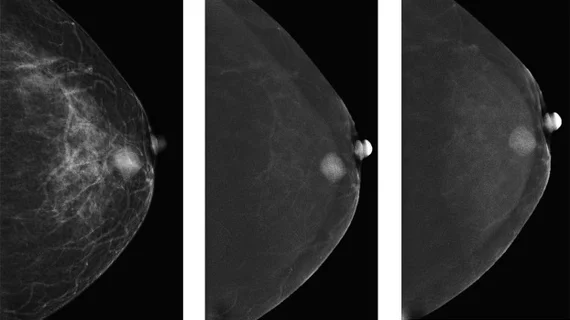Use of the Kaiser score when interpreting contrast-enhanced mammography could be even more beneficial than BI-RADS when distinguishing malignant and benign breast lesions, a recent analysis shows.
The Kaiser scoring (KS) scoring system—introduced in Baltzer et al.in 2013—is a decision tree flowchart that assists radiologists in differentiating between benign and malignant MRI-enhancing lesions based on a large database with 17 different diagnostic criteria. Scores range from 1-11, with higher scores indicating increased likelihood of malignancy. Its use with breast MRI has been shown to have high diagnostic accuracy and the potential to reduce unnecessary biopsies.
While dynamic contrast-enhanced MRI achieves the highest sensitivity for breast cancer detection, its application is limited by costs, availability and low specificity. Contrast-enhanced mammography is a comparable option, but like MRI, it also lacks in specificity.
In 2022, the American College of Radiology released the CEM Breast Imaging Reporting and Data System (BI-RADS) for image interpretation specific to CEM. Corresponding author of a new paper published in the European Journal of Radiology, Xiaocui Rong, of The Fourth Hospital of Hebei Medical University in China, and colleagues explained that while BI-RADS does benefit CEM interpretation, it is not without its shortcomings [1].
“The BI-RADS dictionary does not offer defined criteria for converting specific image features into diagnostic categories. It is necessary to explore a scoring system to help radiologists characterize imaging findings and improve their specificity for breast-enhancing lesions,” the authors wrote.
Enter the Kaiser score.
When researchers compared BI-RADS assessments to the final KS of 375 breast lesions, they found that the scoring system achieved higher AUCs and similar sensitivity to BI-RADS. For specificity—a metric that has been somewhat unpredictable in breast MRI and CEM—the KS performed significantly better than BI-RADS.
The authors also revealed that the application of the KS could have helped to avoid 41.7% to 47.9% of unnecessary biopsies compared to BI-RADS assessments.
The authors noted that while their results indicate a potential role for Kaiser scores in breast imaging interpretations, they are not suggesting that it should replace BI-RADS, but rather that it could serve as a complimentary tool.
To learn more, click here.

